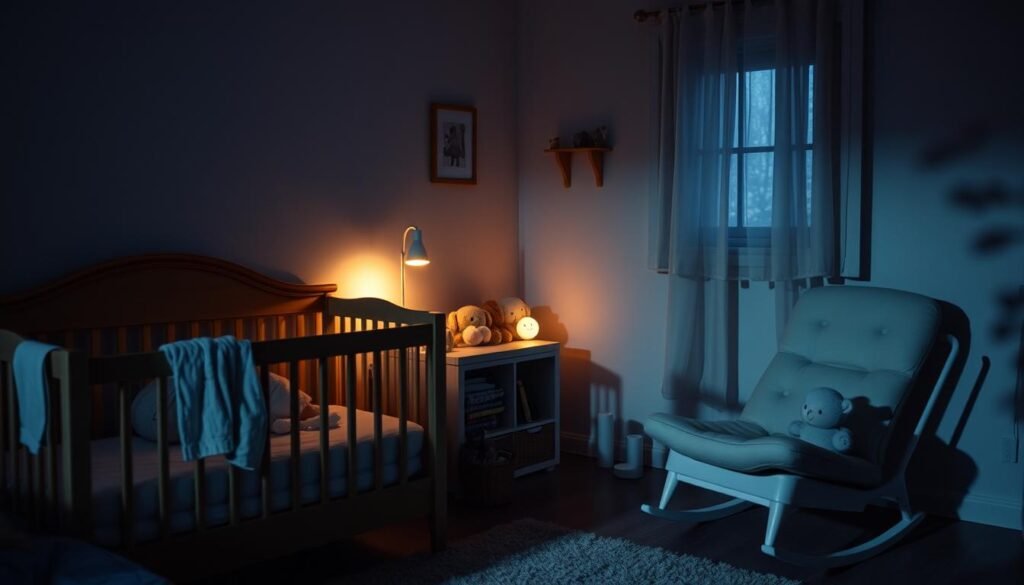I’ve been through the tough times of the 18 month sleep regression with my toddler. It’s really tough to handle when your little one has trouble sleeping at night. This sleep issue is common in toddlers around 18 months old. It’s caused by things like separation anxiety, teething, and changes in their sleep routine.
It’s key for parents to know why this happens. This way, we can find good ways to help our toddlers sleep better. Understanding the reasons behind the sleep regression helps us tackle the problem effectively.
Studies show that 18-month-olds need 11-14 hours of sleep each day. Their bedtime is often between 7-9pm because they only take one nap. To help with the sleep regression, experts suggest a few things. These include giving them chances to move around during the day, extra cuddles, letting them make choices, and feeding them a balanced diet.
I’ll share more about the 18-month sleep regression in this article. You’ll learn how to handle your toddler’s sleep issues and nighttime struggles. This will help your little one get the rest they need to grow and develop well.
Knowing what causes the 18 month sleep regression helps parents take action. We can prevent or lessen its effects. This ensures our toddlers get enough sleep to be happy and healthy.
In the next parts, I’ll go into more detail about the 18 month sleep regression. We’ll look at its causes, signs, and ways to manage sleep problems in 18 month olds. You’ll find helpful tips to overcome your toddler’s nighttime struggles.
Understanding the 18 Month Sleep Regression
As a parent, it’s key to know that sleep regression is a normal part of a toddler’s growth. The 18-month sleep regression can be due to many reasons. These include changes in sleep schedule, separation anxiety, and teething. To tackle it, we must understand what sleep regression is, why it occurs at 18 months, and how long it lasts.
Every child is unique when it comes to sleep patterns. Some may not go through the 18-month sleep regression, while others might face it briefly. This regression can last from 2 to 6 weeks, depending on the child. To handle it, establish a consistent bedtime routine, set clear boundaries, and limit screen time before bed.
Important factors to consider with the 18-month sleep regression include:
- Separation anxiety, which peaks between 9 to 10 months and 18 months
- Mastering developmental milestones, such as walking and expanding vocabulary
- Fear of the dark, teething pain, and illness
By grasping these factors and using effective strategies, parents can manage sleep regression better. Remember, being consistent and patient is crucial when dealing with the 18-month sleep regression.
| Age | Sleep Requirements |
|---|---|
| 18 months | 11-14 hours of sleep every 24 hours, including 1 1/2 to 2 hours of napping |
Signs Your Toddler Is Experiencing Sleep Regression
It can be tough to spot sleep regression in your 18-month-old. Sleep disturbances in 18 month olds show up in many ways. Knowing the common signs is key. Look out for bedtime resistance, more night wakings, and longer naps during the day.
A steady toddler bedtime routine can make a big difference. A calm, predictable bedtime routine tells your child it’s time to sleep. This might include reading, singing, or a warm bath.
Here are some signs your toddler might be struggling with sleep regression:
- Resistance to bedtime
- Increased nighttime awakenings
- Longer or more frequent daytime naps
Many things can cause sleep disturbances in 18 month olds. These include separation anxiety, changes in routine, or hitting new milestones. Knowing these signs and sticking to a toddler bedtime routine can help your child sleep better.
Every child is unique, and what works for one might not work for another. If you’re worried about your child’s sleep, talk to a healthcare expert. They can offer advice tailored just for your child.
| Age | Sleep Requirements | Signs of Sleep Regression |
|---|---|---|
| 18 months | 11-14 hours | Resistance to bedtime, nighttime awakenings, longer daytime naps |
The Science Behind Toddler Sleep Patterns
Understanding toddler sleep patterns is key to better sleep strategies. At 18 months, toddlers see a lot of brain growth. This growth can mess with their circadian rhythm and sleep cycles, making it hard to fall and stay asleep.
Studies show that sleep regression sleep training techniques can help. These include a regular sleep routine, a quiet sleep space, and avoiding too much activity before bed. Also, making sure toddlers get enough daytime sleep is crucial. Most 18-month-olds need 2-3 hours of daytime rest.
Knowing how much sleep is needed is important. The American Academy of Pediatrics says 18-month-olds should sleep 12-14 hours in a day. This breaks down into 10-12 hours at night and 2-3 hours during the day. Here’s a table with the sleep guidelines for 18-month-olds:
| Age | Recommended Total Sleep | Overnight Sleep | Daytime Sleep |
|---|---|---|---|
| 18 months | 12-14 hours | 10-12 hours | 2-3 hours |
By following these guidelines and using sleep regression sleep training techniques, parents can help their toddlers sleep better. This can greatly benefit their development and happiness.
Common Triggers of Sleep Disruption at 18 Months
At 18 months, toddlers often face sleep problems. Separation anxiety is a big reason, as they worry when away from parents. Teething also causes trouble, as the pain makes it hard to sleep.
Changes in sleep schedules can also upset their sleep. For instance, moving from two naps to one can mess with their routine. To deal with sleep issues, it’s key to have a regular sleep time and a cozy sleep area. Here are some tips for handling 18 month sleep regression:
- Stick to a consistent sleep schedule
- Create a bedtime routine that includes calming activities, such as reading or singing
- Ensure the sleep environment is dark, quiet, and at a comfortable temperature

By knowing what causes sleep problems and using these tips, parents can help their child sleep better.
| Age | Typical Number of Naps |
|---|---|
| 18 months | 1-2 naps |
| 2 years | 1 nap |
Physical and Cognitive Developments Affecting Sleep
As a parent, knowing about toddler sleep patterns is key. At 18 months, toddlers go through big changes that affect their sleep. These changes include learning new words, improving motor skills, and growing emotionally. All these changes shape their sleep habits.
Studies show these changes can impact sleep in different ways. For example, learning new words can make their brains work harder at night. This can make it hard for them to relax. Also, as they get better at moving, they might be more active during the day. This can make it tough to sleep well at night. Lastly, emotional growth can lead to feelings of separation anxiety. This can make it hard for them to fall asleep or stay asleep.
Impact of Developments on Sleep
To grasp how these changes affect sleep, let’s look at a few points:
- Language explosion: Increased brain activity can make it difficult for toddlers to fall asleep.
- Motor skill development: Increased physical activity can affect sleep quality.
- Emotional growth: Separation anxiety and other emotional challenges can impact sleep.
By understanding how to improve toddler sleep, parents can help their child sleep better. This might mean having a regular bedtime routine, making their bedroom sleep-friendly, and avoiding exciting activities before bed. By focusing on sleep, parents can help their toddlers develop good sleep habits. These habits will help them sleep well for the rest of their lives.
| Development | Impact on Sleep |
|---|---|
| Language explosion | Increased brain activity, difficulty falling asleep |
| Motor skill development | Increased physical activity, affected sleep quality |
| Emotional growth | Separation anxiety, emotional challenges, impacted sleep |
Creating an Effective Bedtime Routine
Creating a toddler bedtime routine is key for better sleep. Studies show that a routine with a set sleep schedule, a dark room, and calming activities helps toddlers sleep well. This makes them fall asleep quicker and sleep longer.
A daily routine with regular naps, meals, play, and bedtime makes toddlers feel safe. It’s best to avoid giving them a dummy at night. Instead, use a cuddly toy or blanket for comfort.
Effective sleep regression sleep training techniques include a 3-step bedtime routine. This can be a bath, massage, and quiet time with a lullaby. Parents have seen their kids sleep better and longer in just 2 weeks.

Tools like SNOObie can also help. It has a sound machine, nightlight, and an OK-to-wake sleep trainer. A consistent bedtime routine and these techniques help toddlers sleep better.
| Age | Recommended Bedtime | Sleep Duration |
|---|---|---|
| 12-36 months | 8-8:30 pm | 11-14 hours |
Dealing with Nighttime Wake-Ups
Being a parent can be tough, especially when dealing with sleep regression at night. Babies at 18 months might wake up more, refuse naps, and have trouble falling asleep. It’s crucial to find ways to handle these nighttime wake-ups effectively.
Creating a consistent sleep routine is key. Stick to a regular bedtime, make the sleep area calm, and avoid too much excitement before bed. These steps help babies develop good sleep habits and wake up less at night.
Here are more ways to cope with sleep regression:
- Let toddlers choose a book or toy before bed
- Plan fun activities during the day to help sleep
- Keep sleep routines the same every night
By using these strategies and staying consistent, parents can guide their babies through the 18-month sleep regression. Remember, sleep regressions are a normal part of growing up. With patience and effort, parents can help their babies sleep well for years to come.
Common Mistakes Parents Make During Sleep Regression
Dealing with the 18-month sleep regression can be tough for parents. It’s key to understand toddler sleep patterns to get through this phase. Knowing what not to do is just as important as knowing what to do.
Some common mistakes include not sticking to bedtime routines, getting the timing wrong, and not responding well to your child. For example, inconsistent sleep schedules can mess up a child’s natural sleep cycle. This makes it tough for them to fall and stay asleep.
To avoid these mistakes, parents should aim for a consistent sleep routine. They should also watch for signs that their child is tired and respond to their needs. This helps their child develop good sleep habits and improves sleep quality.
Some ways to improve toddler sleep include:
- Creating a calm bedtime environment
- Keeping a regular sleep schedule
- Teaching self-soothing skills
By understanding toddler sleep patterns and avoiding common mistakes, parents can help their child get through the 18-month sleep regression. This knowledge is vital for improving toddler sleep and making the transition smoother.
| Mistake | Effect | Solution |
|---|---|---|
| Inconsistent sleep schedules | Disrupts natural sleep-wake cycle | Establish a consistent sleep routine |
| Timing errors | Leads to overtiredness or undersleeping | Watch for signs of tiredness and respond appropriately |
| Response problems | Exacerbates sleep regression | Develop a consistent response strategy |
When to Seek Professional Help
Being a parent can be tough, especially when your child’s sleep is off. Sleep regression can mess with your child’s sleep and happiness. If you’re finding it hard to deal with, it might be time to get help from a pro.
Experts say getting help is key when sleep regression is tough. They can teach you how to improve your child’s sleep and tackle common problems. Signs you might need help include ongoing sleep issues, trouble setting a sleep schedule, and feeling stressed about your child’s sleep.
Getting professional help can offer many benefits. You’ll get:
- Personal advice on sleep training techniques
- Help in setting a consistent sleep routine
- Ways to handle sleep regression and reduce its effects
Coping with sleep regression takes patience, consistency, and the right methods. Professional help can help you understand your child’s sleep needs better. It can also teach you how to manage sleep problems. Remember, every child is different, so what works for one might not work for another. If you’re struggling, don’t be afraid to ask for help.
“Sleep is essential for a child’s physical, cognitive, and emotional development. By seeking professional help, you can ensure your child gets the sleep they need to thrive.”
Conclusion: Moving Past the 18 Month Sleep Regression
The 18 month sleep regression is a common challenge for parents. But, it doesn’t have to be a constant fight. With the right steps, you can help your toddler get past this tough time and start sleeping well again.
Understanding why your toddler is struggling with sleep is key. It could be due to changes in their toddler nighttime struggles or sleep disturbances in 18 month olds. By setting a regular bedtime routine, making their sleep area cozy, and teaching them to calm down on their own, you can ease their transition.
Keep in mind, the 18 month sleep regression is just a phase. With patience and sticking to a plan, your toddler will get through it. By focusing on their sleep and making changes when needed, you can help them get the rest they need to grow.


